Gmail to Zoho Mail Migration: A Step-by-Step Guide for Secure Email Transition
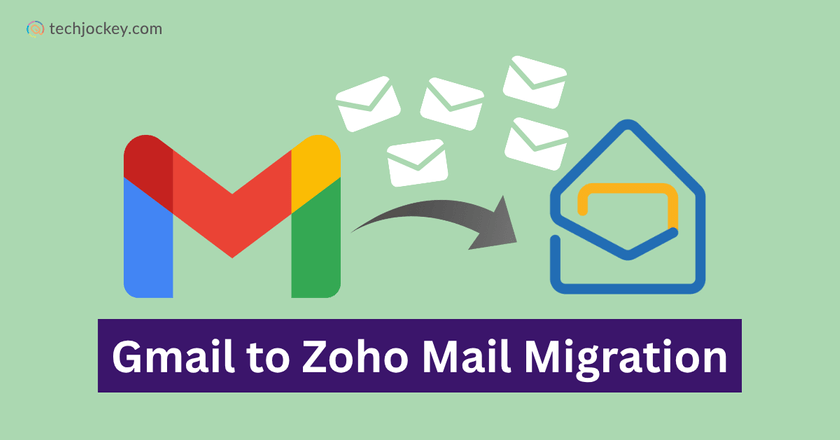
As per the latest news, Home Minister Amit Shah has publicly announced his official Zoho email address on X. Zoho is an Indian-grown service that has gained a lot of popularity after this announcement. Indian government’s Atmanirbhar Bharat and Digital India initiatives are totally relatable with this change from Gmail to Zoho.
Zoho consider itself a strong, and privacy-focused alternative to Gmail that also offers an ad-free experience. Many Gmail users are now curious and are exploring Gmail to Zoho Mail migration ways.
So, this guide will help you understand everything in detail about what exactly changes after you switch to Zoho email software, what benefits you will gain, and how you can do this smoothly.
Let’s begin.
Why Migrate from Gmail to Zoho Mail?
The email migration from Gmail to Zoho has a number of benefits over Gmail:
- Privacy is priority: Zoho Mail does not scan mail to offer advertisements, and your messages are safe.
- No ads between: A clean interface increases productivity.
- Email recall time: Zoho Mail allows recalling emails anytime, unlike Gmail’s short undo window, though recipients get a recall notice.
- Paid plans are pocket-friendly: Zoho mail starts at INR 50 per user per month whereas Gmail starts at INR 160 per user per month.

Zoho Mail
Starting Price
₹ 708.00 excl. GST
Gmail Structure and Its Implications
Gmail organizes emails using ‘labels’ rather than folders. Each email can have multiple labels, which allows it to appear in several places at once.
Gmail to Zoho Mail Migration Impact:
- During migration, Gmail labels are converted into folders in Zoho Mail.
- Emails with multiple labels may be duplicated in Zoho Mail folders, increasing storage usage.
Example:
A 10 MB email labeled Inbox, Work, and Important could take up 30 MB in Zoho Mail if all labels are migrated.
Pro Tips:
- Minimize overlapping labels in Gmail before migration.
- Exclude redundant labels, like Important, to reduce duplication.
- Plan folder mapping carefully to avoid bloated mailbox size.
Gmail to Zoho Mail Migration Steps
Here’s a simple guide on how you can migrate from Gmail to Zoho mail:
Step 1: Preparing for Migration
Before starting, Zoho Mail needs authorization to access your Google Workspace account. This ensures a secure and easy transfer of emails, contacts, and calendar data.
What information you need?
- Super Admin Email Address of Google Workspace
- Email Address of Service Account
- JSON or P12 Key File for authentication
Once you have all the above information, you can further move to the below steps.
Step 2: Adding Server Details in Zoho Mail
The first step in Zoho Mail Admin Console is adding the server configuration.
1. Sign in to ‘Zoho Mail Admin Console’ → ‘Data Migration’.
2. Click ‘Start Migration’ if migrating for the first time or ‘+ Create’ for subsequent ones.
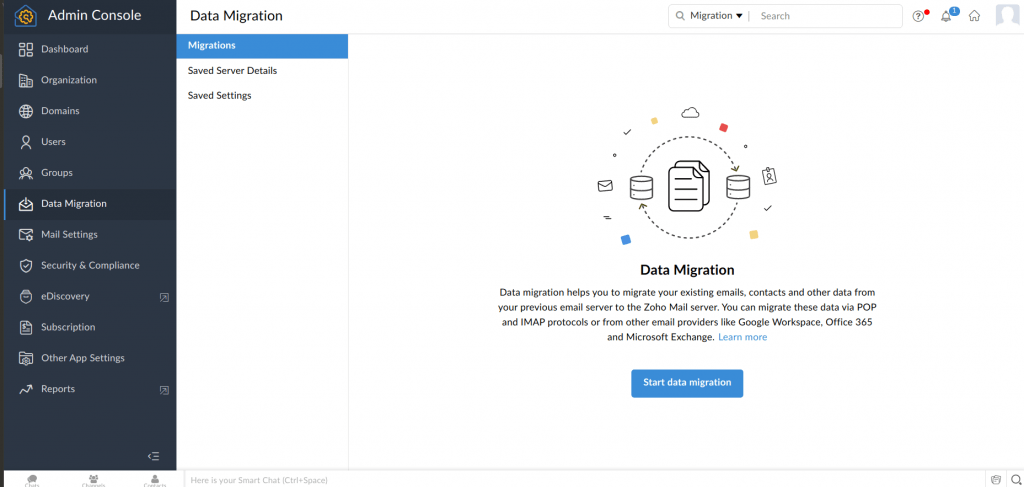

3. Enter a descriptive name for your migration server configuration.
4. In ‘Select Protocol/Application’, choose ‘Google Workspace’.
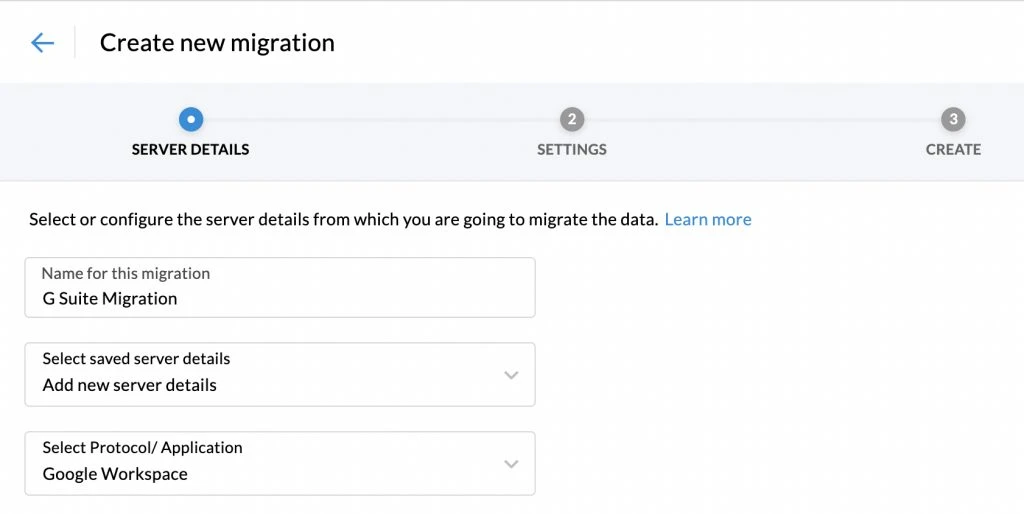

5. Provide your Super Admin Email and Service Account Email.
6. Upload the JSON or P12 Key File.
7. Click ‘Authenticate’ to save the server details.
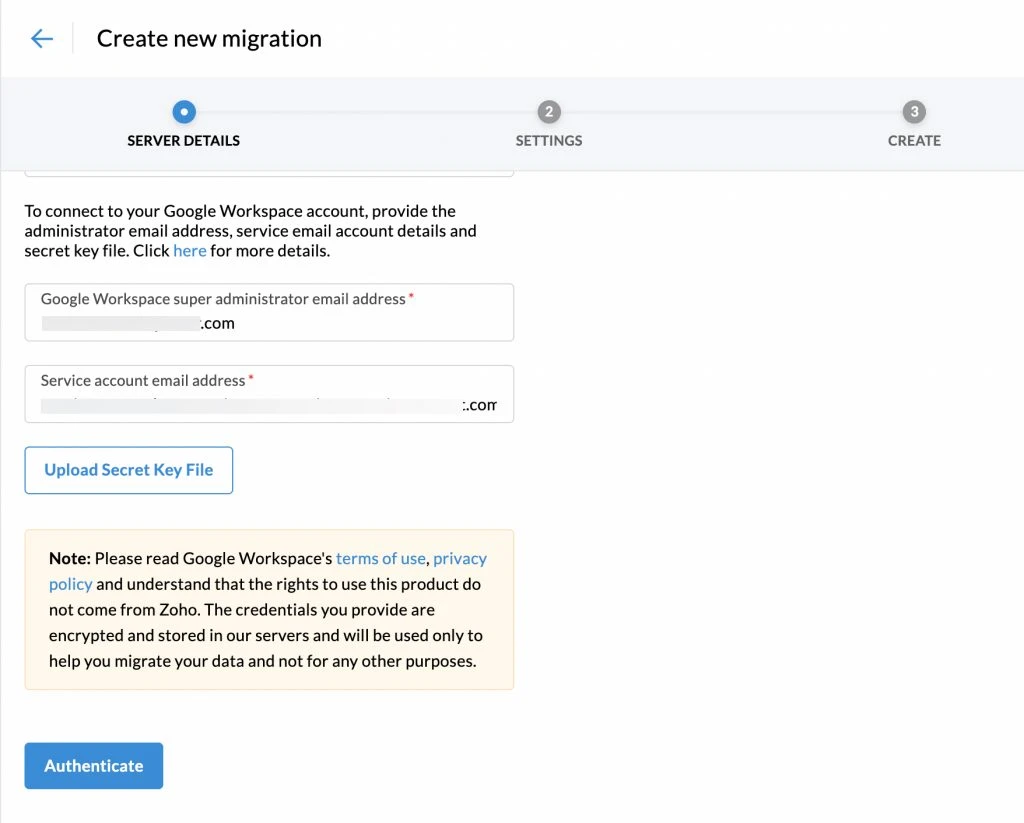

These settings are stored in Saved Server Details, so future migrations can use the same configuration without re-entering credentials.
Step 3: Configuring Migration Settings
This step lets you choose exactly what data to migrate. Zoho Mail provides flexible options for emails, contacts, and calendars.
1. Choose What to Migrate
Zoho Mail allows you to move three types of data from Google Workspace:
- Emails: All Gmail messages, along with their folder structure.
- Contacts: All saved contacts, categorized properly in Zoho Mail.
- Calendars: All calendar events, including recurring and shared ones.
You can enable or disable any of these options based on what is relevant for your organization.
Tip: If you are migrating calendars, make sure that all users already exist in Zoho Mail. Also, your Gmail domain should exactly match with the Zoho Mail domain, like if Gmail uses abc.com, Zoho Mail should use the exact same address.




Zoho Mail
Starting Price
₹ 708.00 excl. GST
2. Select Which Folders to Include
Not all folders need to be moved. For instance, you might not want to carry over spam or promotional emails. Zoho Mail gives you the flexibility to include or exclude folders as needed.
You have three main options here:
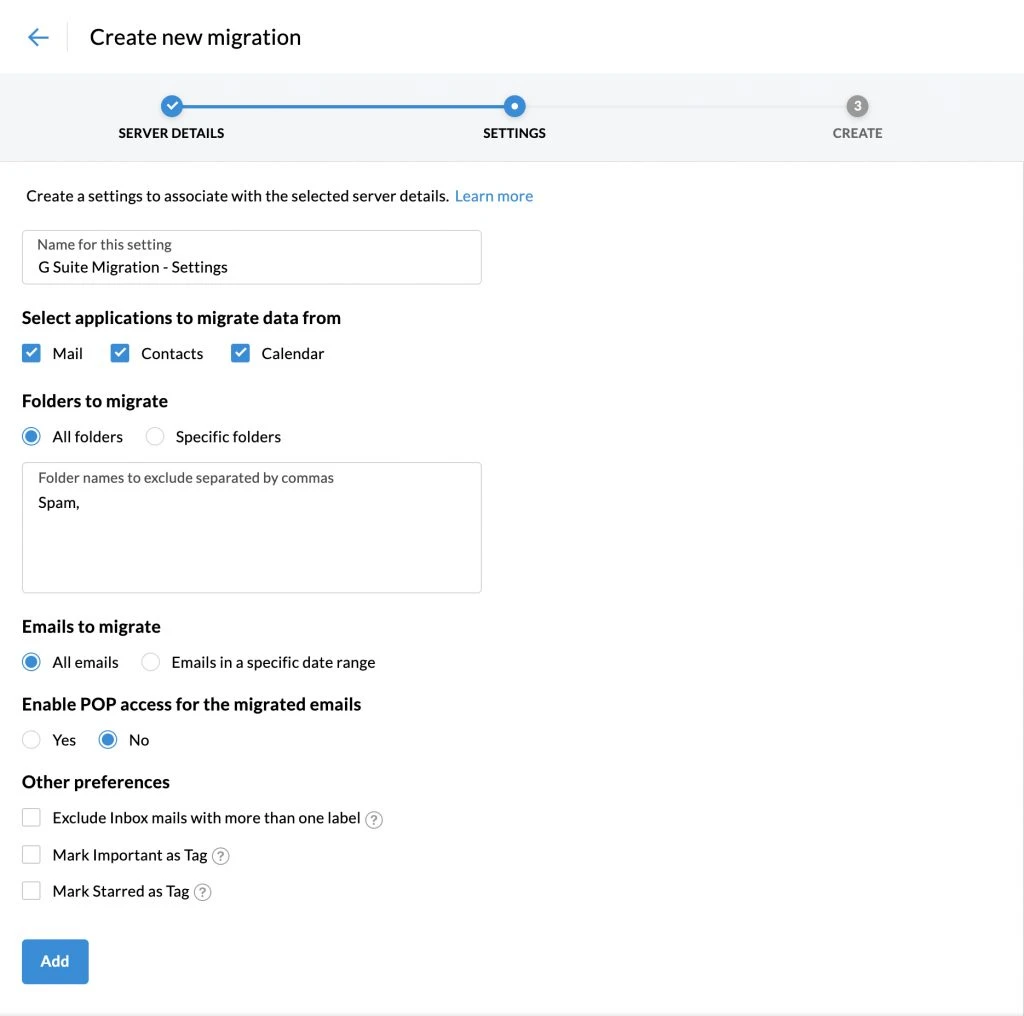

- All Folders: In this, you can migrate everything from your Gmail account including all mails from inbox, sent, or any custom folder.
- Specific Folders: Choose only the folders you want. It is ideal when you want a focused migration, for example, only business-related emails.
- Exclude Folders: Skip certain folders such as Spam, Trash, or Promotions to save space and time.
3. How Folder Naming Works
To help Zoho identify which folders you are referring to, you will need to use a specific naming format:
| Example | Meaning |
|---|---|
| Inbox/* | Migrate all subfolders under Inbox. |
| Reports/2016 | Migrate only the 2016 subfolder inside Reports. |
| Sales Reports/* | Migrate all subfolders under Sales Reports. |
This convention gives you precise control over what gets moved, especially when dealing with nested folder structures.




Zoho Mail
Starting Price
₹ 708.00 excl. GST
4. Migrating Data by Date
Sometimes, you may not require all historical emails especially for large mailboxes. With Zoho Mail, you can filter emails by date range.
You can choose between:
- ‘All Emails’ to move the entire mailbox starting from the day it was created.
- ‘Specific Date Range’ and select custom From and Till dates to migrate only a certain period, for example, emails from 2022 to 2025.
This feature helps reduce Gmail to Zoho mail migration time and avoids transferring outdated or irrelevant data.
5. POP Access Option
During this configuration step, you will also notice a setting for ‘POP access’. This determines whether the migrated emails can later be viewed in other email clients like Outlook or Thunderbird using the POP protocol.
- Select ‘Yes’, if you want users to download and view these migrated emails via POP.
- Select ‘No’, if you plan to use Zoho Mail’s web interface or IMAP access only.
For example, if your team still uses Outlook as their main client, enabling POP ensures continuity after migration.
Step 5: Additional Migration Preferences
Zoho Mail allows customization to optimize migration:
- ‘Exclude Inbox mails with multiple labels’ to prevent duplicate emails
- Mark Important as Tag: Gmail Important emails become ZMImportant
- Mark Starred as Tag: Gmail Starred emails become ZMStarred
These settings ensure your mailbox is clean and organized post-migration.
Step 6: Creating the Migration Task
After configuring settings:
1. Choose ‘Maximum Connection Limit’ to set the number of users migrating simultaneously.
2. Choose a ‘Pause Threshold’ if you want to stop the migration when storage reaches to 80% or 95%.
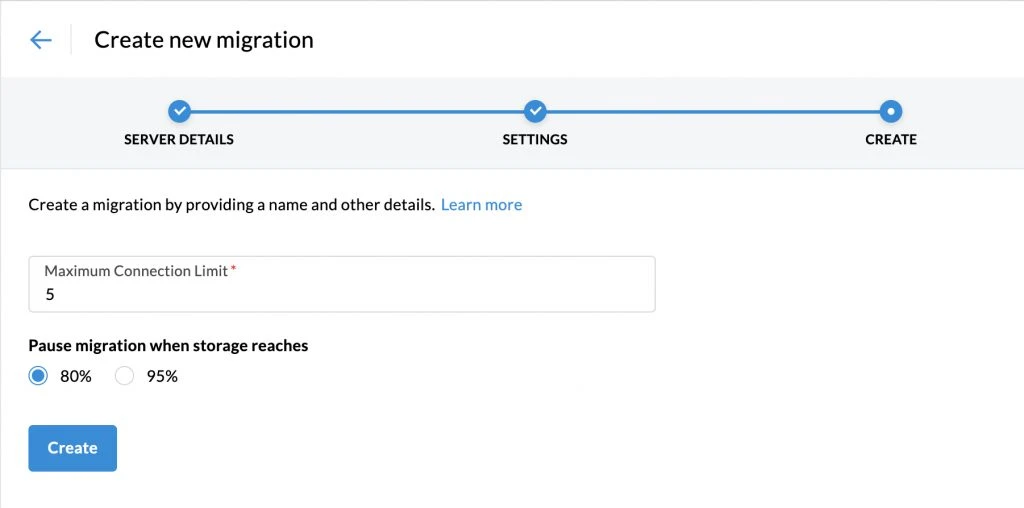

3. Click ‘Create’ to finalize the migration task.
Parallel migrations help speed up the process without overloading the servers.
Step 7: Adding Users for Migration
Zoho Mail provides three methods to add user accounts:


Manual Addition
- Add Gmail and Zoho email addresses individually.
- Optionally, prioritize users for migration.
Bulk Upload via CSV
- Prepare a CSV file with source (Gmail) and destination (Zoho) email addresses.
- Upload in Zoho Admin Console and verify accounts.
- Useful for large teams or organizations.
Fetch Directly from Google Workspace
- Pull all user accounts directly from the source server.
- Select accounts to migrate and add them with one click.
Step 8: Starting the Gmail to Zoho Mail Migration
Once users are added:
1. Click ‘Start Migration’ in Zoho Mail Admin Console.
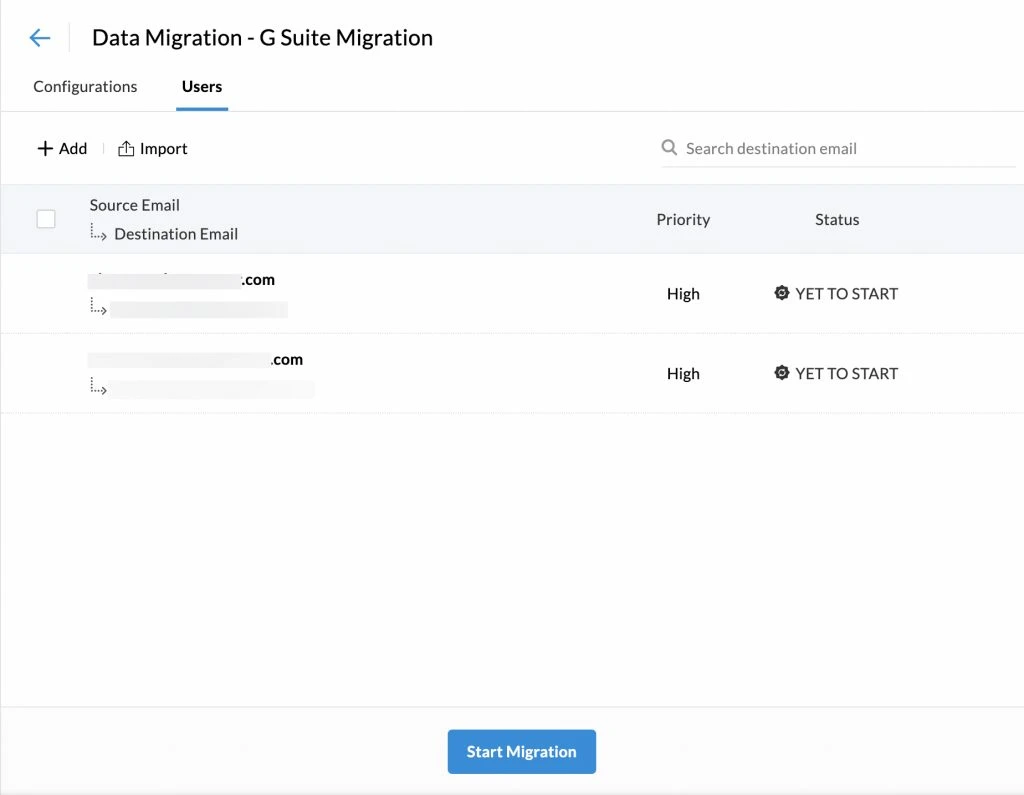

2. Ensure Gmail passwords remain unchanged during migration.
3. Monitor progress in real-time by going to specific folders of Mail, Contacts, and Calendar.
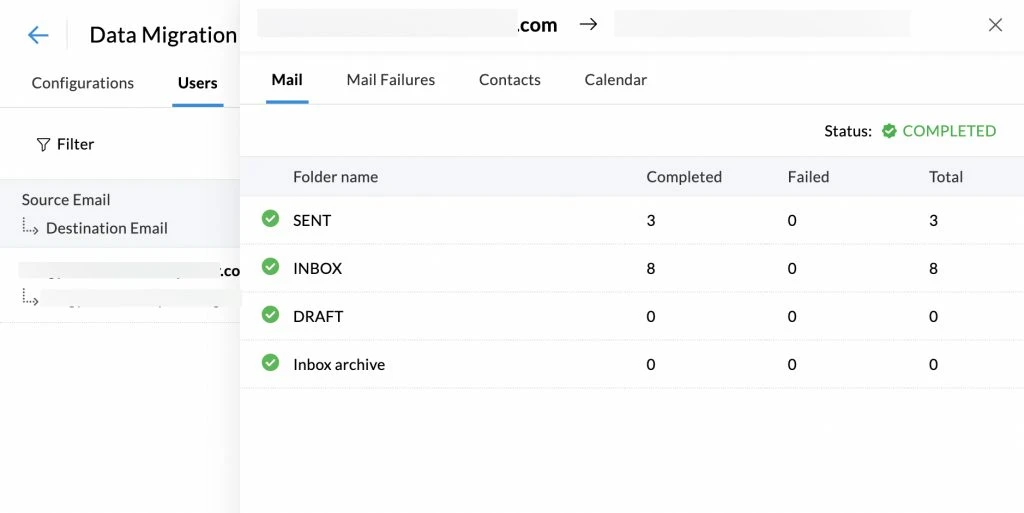

4. You must keep an eye on migration logs to quickly address any failures or missed emails.
Troubleshooting Common Migration Issues
Even with a careful setup, some issues can occur. Here’s how to address them:
- Duplicate Emails: Caused by multiple Gmail labels. Use the ‘Exclude Inbox mails with multiple labels’ option.
- Calendar Errors: Ensure all users exist in Zoho Mail and domains match.
- Authentication Failures: Verify JSON/P12 key file is valid.
- Missed Emails: Rerun migration for specific folders using the Include/Exclude Folder List.
- Large Mailboxes: Break migration into batches by using date ranges.
Tips for a Smooth Migration
- Communicate with your team about temporary restrictions.
- Backup Gmail data for safety.
- Run a pilot migration for a small group to detect issues.
- Monitor Zoho Mail storage quotas during migration.
Conclusion
Leaving Gmail and switching to Zoho mail is not only about transferring emails, but also about switching to a secure, organized and professional platform. The tools available within Zoho Mail enable you to transfer emails, contacts, calendars, and Google Drive files fast and securely.
This guide will help you to get a trouble-free Gmail to Zoho Mail migration, save your data, and have a privacy-oriented ad-free email experience. No matter who is using it, an individual or a company, switching to Zoho Mail gives a better level of control, security, and collaboration, which is a strong reason to use it over Gmail.
Mehlika Bathla is a passionate content writer who turns complex tech ideas into simple words. For over 4 years in the tech industry, she has crafted helpful content like technical documentation, user guides, UX content, website content, social media copies, and SEO-driven blogs. She is highly skilled in... Read more




























